Paludariums are unique tanks to in-house various species. Various styles and enhanced creativity make them unique. However, a paludarium tank requires proper maintenance for optimal conditions and longevity. In this article, you’ll learn about styles and how to build a paludarium. Paludarium maintains tips for general and plant perspectives, which are also a part of the article.
Content Table
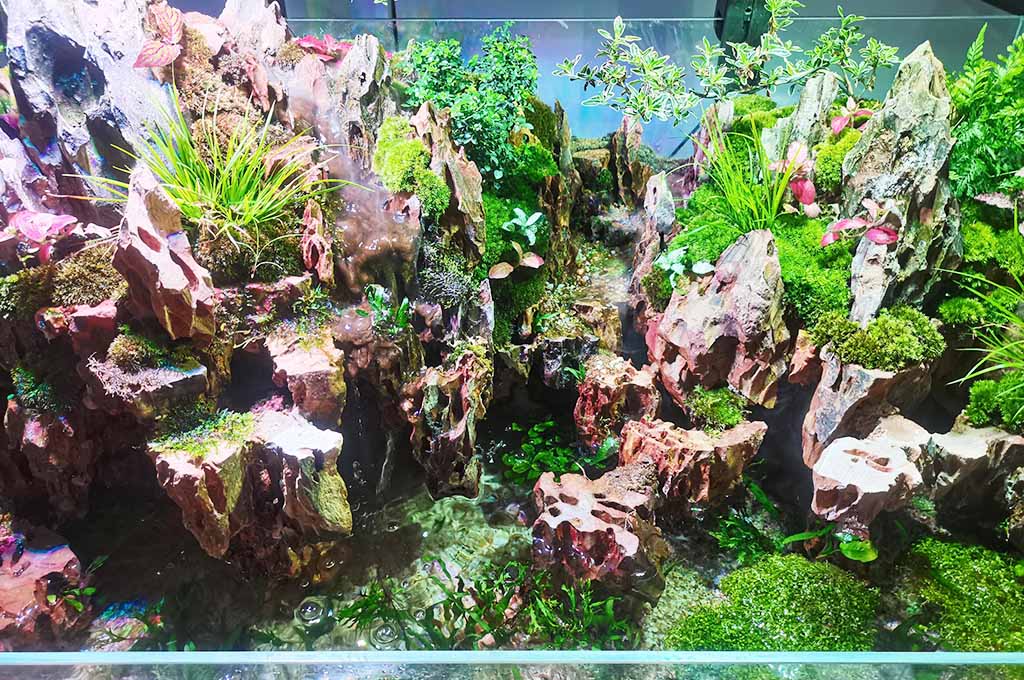
Paludarium tank maintenance
Paludarium Meaning and Style
A paludarium is a fusion of an aquarium and a terrarium. It’s often known as waterfall aquariums or aqua terrariums. It usually has amphibious animals, i.e., semiaquatic crabs, frogs, and reptiles, i.e., turtles. A paludarium creates high air humidity conditions that mimic swampy biotopes.
Paludarium Styles
Paludarium comes in multiple styles. Some of the most common styles regarding habitats are the following.
Reptile Paludarium
They are designed for semiaquatic reptiles, i.e., water dragons, frogs, turtles, and snakes. These reptile paludariums include hiding spots, basking areas, and swimming areas.
Fish Paludarium
They are uniquely designed in such a way that they have dry or semi-submerged areas alongside water areas. A dry area with a large water pool is a salient feature of this paludarium. Dry or land area serves amphibious creatures, i.e., newts, fire salamanders, salamanders, toads, etc. They inhabit fish, aquatic plants, and amphibious animals.
Plants Paludarium
They are focused on creating a lush green setup with aqua pets. Technically, plants are not a part of the paludarium. They mainly create a focal point as plants for the Paludarium get the public attention. Anubias, Java moss, Buce, Brazilian pennywort, etc., are common plants to design a plant paludarium.
Turtle Paludarium
The turtle paludarium varies from the reptile paludarium as it’s designed specifically for turtles. They have a large swimming and specific areas. They are easy to clean and have a strong filtration system with a smooth surface.
Frog Paludarium
This paludarium is special to host only frogs, unlike reptile paludarium. Large but water areas with plenty of hiding spots are the key aspects of its design. They are known for their high humidity and low-temperature design, which means they do not have any basking area.
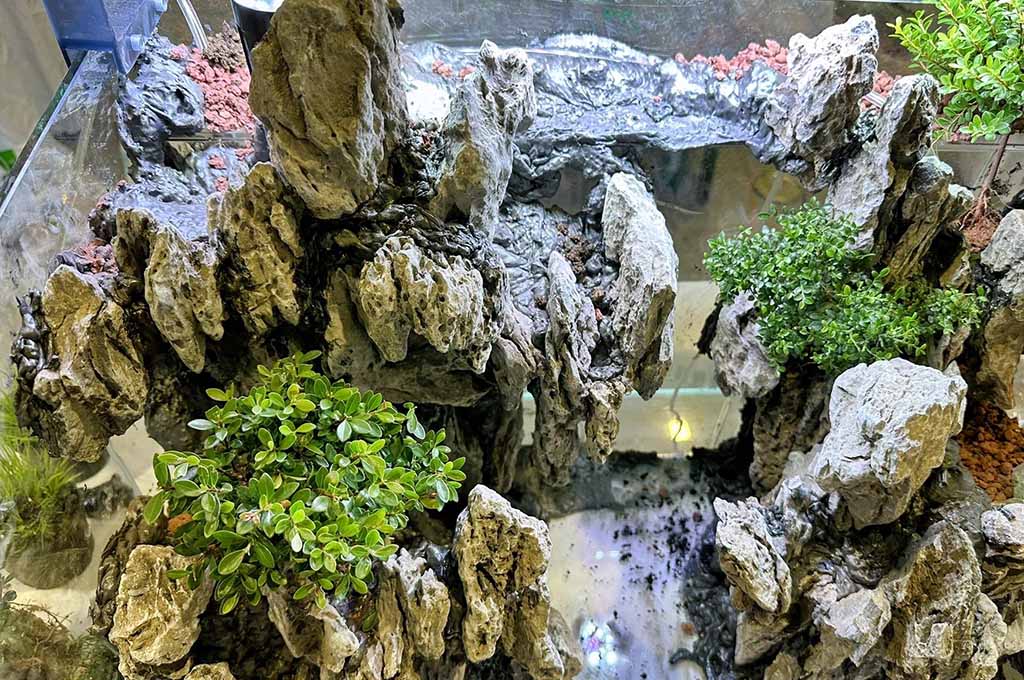
Paludarium maintain tips
The Point of the Paludarium Build
It requires numerous aspects to consider. Here is a step-by-step guide to building a paludarium.
Planing
Planning is the key to a successful paludarium. You have to look at various things.
There are multiple styles and design aspects. Therefore, select the design that suits you most, i.e., rainforest, island-style, etc. With a specific animal, you need to provide it with the desired requirement. Select the animals that match or fit with your style.
Also, whether you’ll build it yourself, i.e., DIY, or use ready-made objects. Count all extra requirements you want to introduce in the tank. Make a rough sketch, and then detail the design of your paludarium on paper for smooth working.
Gather Items
After design completion, it’s time to gather accessories. Have a desired size watertight glass tank for both land and water. Tropical and aquatic soils go well with land and water areas, respectively. Large rocks or foam filter pads are most suitable for building the land area. You can also use egg crate shelves to make it.
Also, don’t forget to bring dynamic rocks and driftwood. It helps to elevate the aesthetic sense of the tank, besides building a structure. UV lights, misting or fogging or waterfall system, filtration accessories, and heating items, i.e., heater or heating rods, should be there before building the paludarium.
Building the Paludarium
After gathering the accessories, it’s time to tie them all. For that, lay a foundation. Set the drainage layer at the bottom. Place pumps, hardware elements, and filter installation. Install the hardscape element, i.e., rocks, driftwood, etc., on the foundation to hide them completely.
Add tropical soil on the land up to the adequate plating depth. Here, you can build any landscape in your paludarium.
Check the Functionality
It’s time to check the system. Fill the water area with water and check the leakage and functionality of all components. Aside from that, run the filter, heater functionality, and other hardware components.
Plantation
After checking, do a plantation in your tank. Grow the immersed plant in a water area. For land sites, tropical vines and terrestrial plants do well. Some addition of moss and epiphytes will make it greener.
Final Touch
Before adding the bioactive crew, introduce cleanup pets, i.e., springtails and isopods, to clean the water from waste or other unwanted materials. Cycle the tank and introduce your desired animals or bioactive crew.
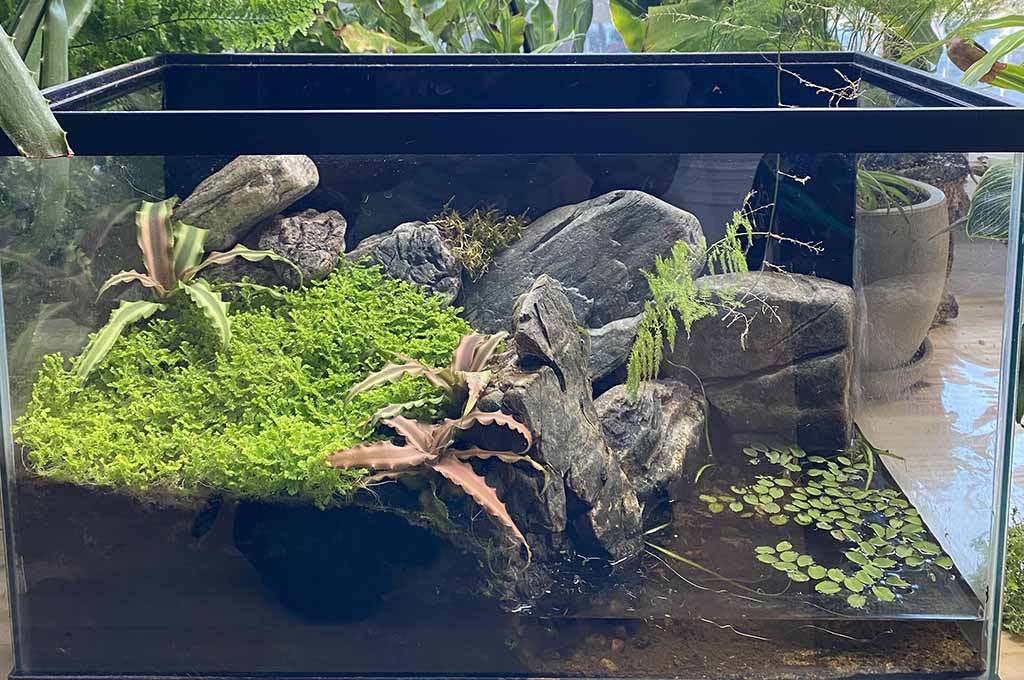
Paludarium Tank Maintenance Tips
Paludarium Tank Maintenance Tips
You can enhance the lifetime of your paludarium with proper maintenance. Moreover, it also enhances the beauty of the tank. It requires following some tips. Here are these paludarium maintenance tips.
Optimize Hygiene
Always feed your pets according to the requirements because overfeeding can pile food on the floor. It results in algae, fungi, or mold spread in the tank. Moreover, ensure the proper aeration. It helps to avoid fouling. Other than that, keep the bottom clean. If you feel any unwanted organism on the substrate, remove it or wash the substrate with a cleaning set.
Humidity Control
Humidity is among the major things in such tanks. Therefore, properly manage it with a balanced ventilation and humidifying system. Automatic foggers, fountains, and misters can help in this regard. Optimal humidity promotes plant growth in the tank.
Suitable Design
Using a removable front silicone glass is highly recommended. It’ll help you to clean or manage things with great ease.
Temperature Control
Temperature is another salient management aspect for bioactive crew and plants. Ensure the temperature is between 24-26°C. However, in any case, it should not be higher than 30-35°C. You can do it with a waterfall. Using a root heating system promotes proper plant growth.
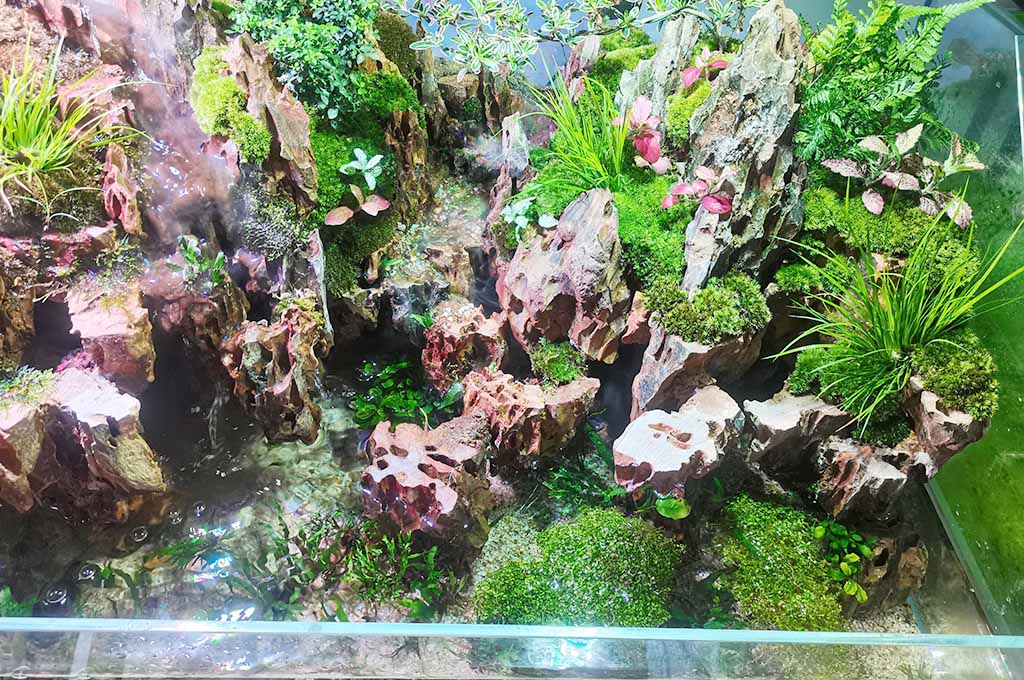
Keep Paludarium tank aesthetics
Maintain Paludarium Plants
It’s far more necessary to maintain the plants properly. The plants that grow in the land area of a paludarium require extra attention. Here are tips for all kinds of paludarium plants.
Plant Selection
Plant selection is the most vital aspect of growing and managing plants. Here are some easy-to-grow plants for Paludarium tanks.
| Plant Name | Characteristics |
| Java Moss | Grows well in both land and water areas |
| Dwarf Equisetum | Adds interesting texture Need seasonal replacement |
| Ferns | Grow well in wet soil |
| Pothos | Suitable for land areas |
| Anthurium | Requires adequate light Flower throughout the year |
| Peace Lily | Optimal for the water area |
| Arrowhead Plant | Multiple colorations and shapes |
| Myosotis | Thrive for a few seasons Forget-me-not is another common name Grow in wetland |
Pruning and Trimming
They can overtake your paludarium without proper pruning. Therefore, ensure to prune your plants into the desired shape and size. Regularly remove the damaged foliage, extra barks, and diseased foliage to avoid disease spread.
Lighting
Provide 10–12 lights in the paludarium. However, if required, you can increase it up to 16 hours. Make sure to provide red and purple spectrum LED lights as they enhance photosynthesis. It also helps in plant coloration.
Plant Rotting
Ensure the proper drainage to avoid waterlogged conditions. However, if your plants are facing rot problems, improve air circulation. In extreme cases, install a new layer of fresh substrate.
Substrate and Fertilization
Soil is another important parameter for proper plant growth. Always use well-drained soil. You can make it with the aquatic and regular soil mixture. Although, they don’t require regular fertilization. However, if fertilization is inevitable, liquid fertilization is suggested as it properly distributes on the plant.
Plant Size
Small and medium size plants are easy to take care of. Therefore, if you see some large plants, divide them into two or more.
Key Takeaways
- A paludarium is a water and land area combination that enables it to build a diverse habitat in the tank.
- Reptile, plant, tortoise, fish, and frog paludarium are among the common types of paludarium.
- Proper planning, gathering accessories, tying, checking, cleaning, and filling help to build the tank properly.
- Optimize hygiene, humidity, easy design, and temperature for paludarium longevity.
- Proper plant selection, pruning, lighting, rich substrate, and suitable plant size help elevate your tank’s overall aesthetics.
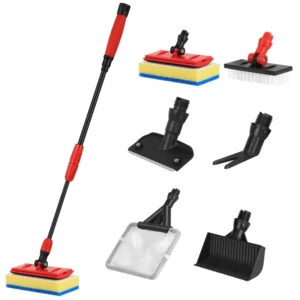
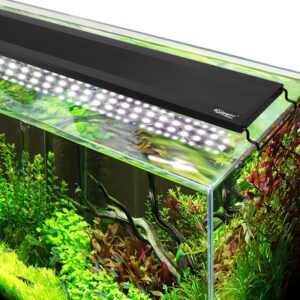
Leave a comment